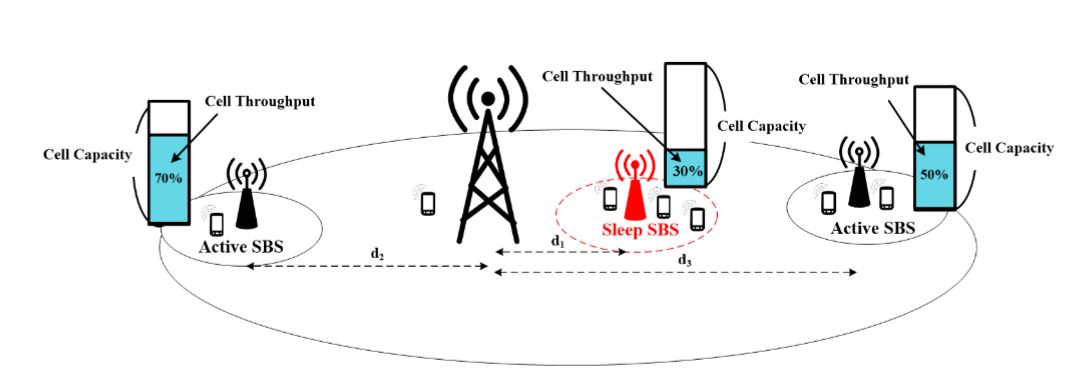Cell Throughput based Sleep Control Scheme for Heterogeneous Cellular Networks
Main Article Content
Abstract
The mobile traffic continuously grows at a rapid rate driven by the widespread use of wireless devices. Along with that, the demands for higher data rate and better coverage lead to increase in power consumption and operating cost of network infrastructure. The concept of heterogeneous networks (HetNets) has been proposed as a promising approach to provide higher coverage and capacity for cellular networks. HetNet is an advanced network consisting of multiple kinds of base stations, i.e., macro base station (MBS), and small base station (SBS). The overlay of many SBSs into the MBS coverage can provide higher network capacity and better coverage in cellular networks. However, the dense deployment of SBSs would cause an increase in the power consumption, leading to a decrease in the energy efficiency in downlink cellular networks. Another technique to improve energy efficiency while reducing power consumption in the network is to introduce sleep control for SBSs. This paper proposes cell throughput based sleep control which the cell capacity ratio for the SBSs is employed as decision criteria to put the SBSs into a sleep state. The simulation results for downlink communications demonstrate that the proposed scheme improves the energy efficiency, compared with the conventional scheme.
Article Details
References
[2] A. Anpalagan, M. Bennis, R. Vannithamby, “Design and deployment of small cell networks,” Cambridge University, 2016.
[3] H. Ishii, Y. Kishiyama, and H. Takahashi, “A Novel Architecture for LTE-B :C-plane/U-plane Split and Phantom Cell Concept,” in Proc. IEEE Globecom Workshops (GC Wkshps), pp. 624–630, Dec. 2012.
[4] S. Parkvall, E. Dahlman, G. Jongren, S. Landstrom, and L. Lindbom, “Heterogeneous Network Deployments in LTE: The Soft-cell Approach,” Ericsson Review, Tech. Rep., 2011.
[5] T. Maeno, K. Mori, K. Sanada, H. Kobayashi, “Evaluation of Energy Efficiency for various Handover Methods in Heterogeneous Cellular Networks with Sleep Control,” in Proc. 6th International Symposium for Substainability, Engineering, Mie University, pp.9–10, Sep. 2016.
[6] P. Phaiwitthayaphorn, P. Boonsrimuang, P. Reangsuntea, T. Fujii, K. Sanada, K. Mori, H. Kobayashi, “Cell Throughput based Sleep Control Scheme for Heterogeneous Cellular Networks,” in Proc. of 14th International Conference on Electrical Engineering/Electronics, Computer, Telecommuni-cation and Information Technology (ECTI-CON), pp.584-587, Jun. 2017.
[7] I. Ashraf, F. Boccardi, L. Ho, “Sleep Mode Techniques for Small Cell Deployments,” IEEE Communications Magazine, vol.49, no.8, pp. 72-79, Aug. 2011.
[8] X. Zhang, S. Zhou, Y. Yan, C. Xing, J. Wang, “Energy Efficient Sleep Mode Activation Scheme for Small Cell Networks,” in Proc. IEEE 82nd Vehicular Tech. Conf. (VTC2015-Fall), pp. 1–4, Sept. 2015.
[9] Y. Soh, T. Quek, M. Kountouris, “Energy Efficient Heterogeneous Cellular Networks,” IEEE Journal on Selected Areas in Communications, vol.31, Issue 5, pp.840-850, May 2013.
[10] S. Samarakoon, M. Bennis, W. Saad, and M. Latva-aho, “Opportunistic Sleep Mode Strategies in Wireless Small Cell Networks,” in Proc. IEEE Inter. Conf. Commun. (ICC), pp 2707–2712, Jun. 2014.
[11] Y. Sheng Soh, T. Q.S. Quek, M. Kountouris, “Dynamic Sleep Mode Strategies in Energy Efficient Cellular Networks,” in Proc. IEEE Inter. Conf. Commun. (ICC), pp 3131-3136, Jun. 2013.
[12] T. S. Rappaport, “Wireless Communications: Principles and Practice Second Edition,” Prentice Hall PTR Upper Saddle River, 2001.
[13] J. S. Seybold, Introduction to RF Propagation, Ltd. Published John Wiley & Sons, 2005.
[14] Y. Chen, Sh. Zhang, Sh. Xu, “Characterizing Energy Efficiency and Deployment Efficiency Relations for Green Architecture Design,” in Proc. IEEE International Conference on Communications Workshops (ICC), May 2010.
[15] 3GPP TR36.417, (V9.0.0.0), Technical Specication Group Radio Access Network, Mar. 2010.
[16] V. Giannini, C. Desset, and I. Godor, “How Much Energy is Needed to Run a Wireless Network?,” IEEE Wireless Communications, vol. 18, Issue. 5, pp. 40–49, Oct. 2011.

